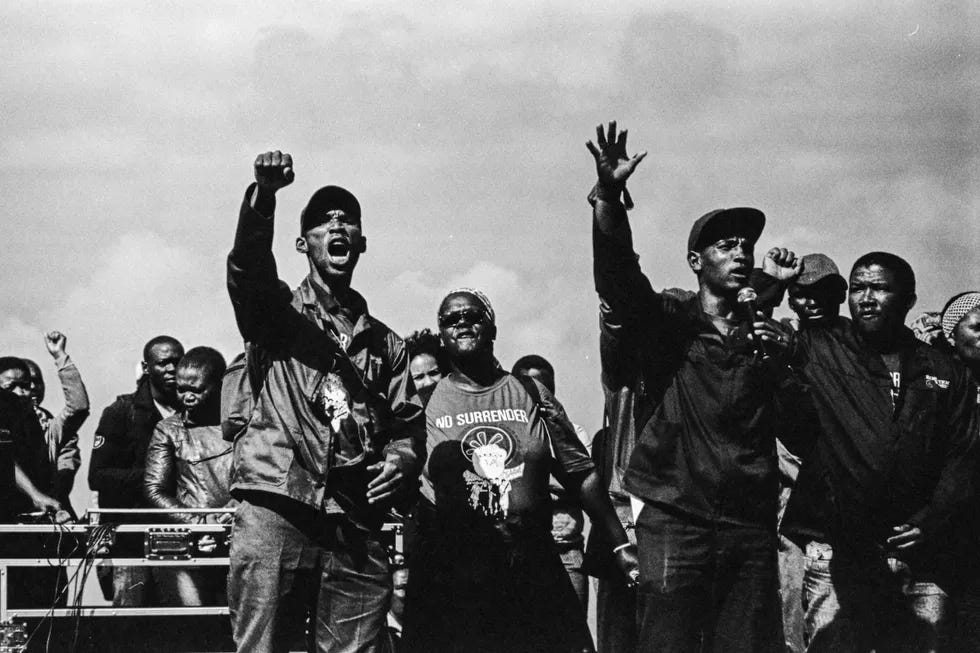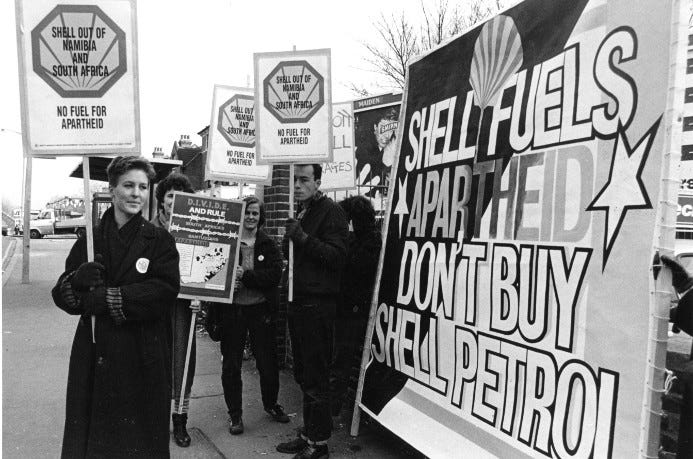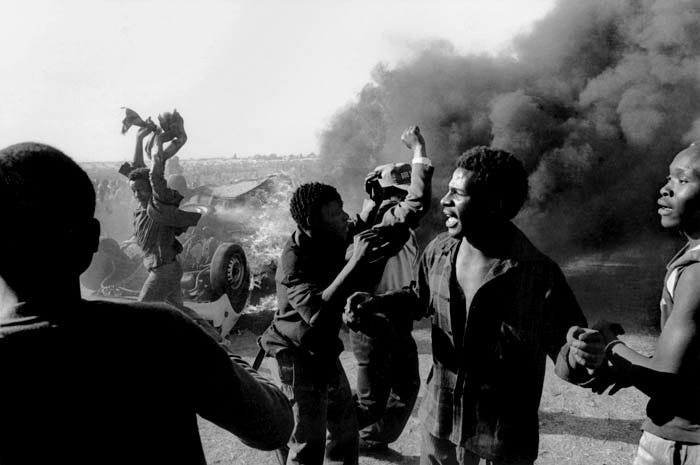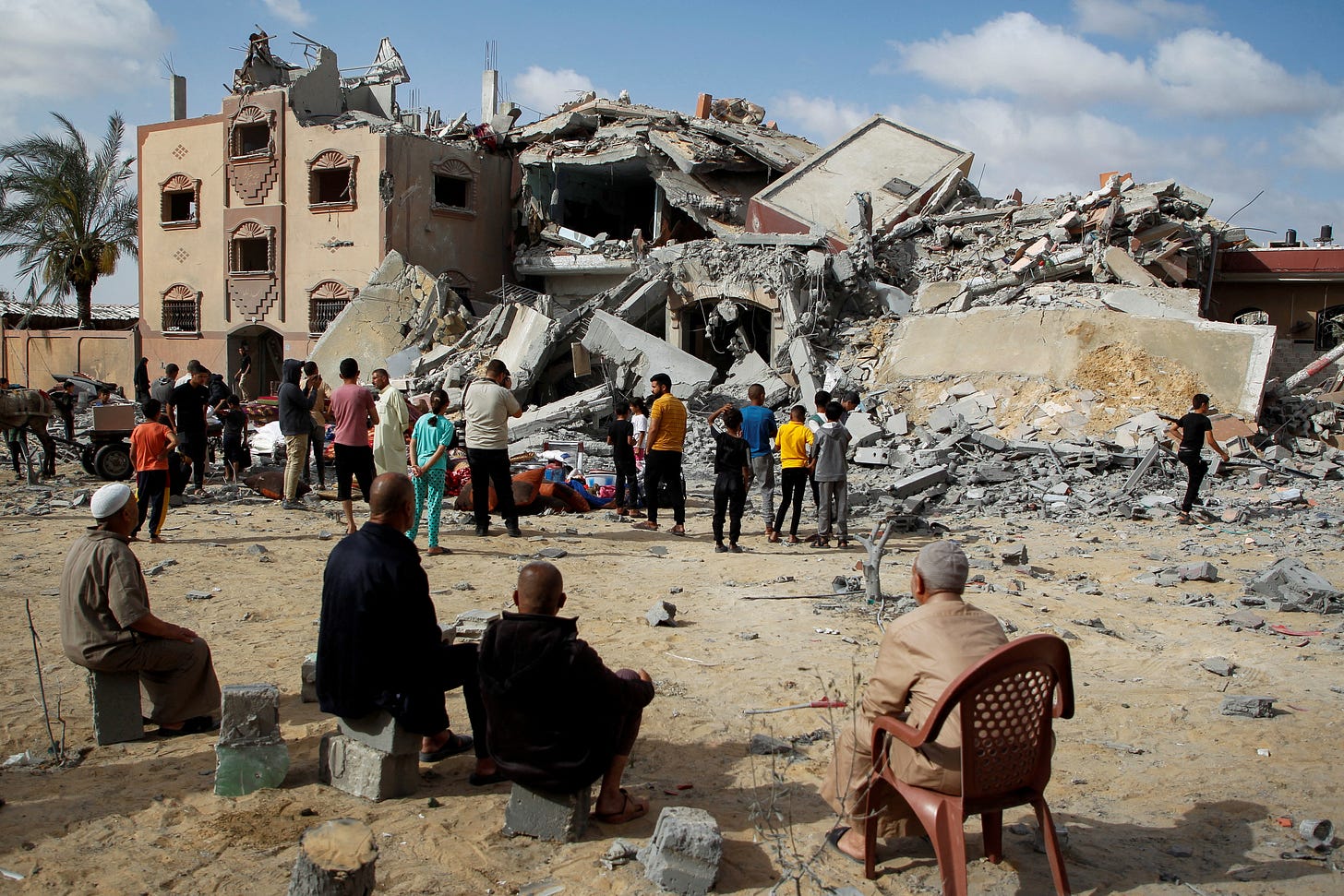What are the lessons we should have learned from the movement to divest from the South African apartheid regime in the ‘70s and ‘80s, and more generally struggles on university campuses from the last half century?
In addition to the $4 billion a year in mostly military aid the US government sends to Israel, plus an extra $17 billion this year to support the ongoing genocide, Israel receives around $30 billion in foreign investment a year,1 80% from the US and UK, and over half in IT and software development, much of which has applications for surveillance of civilians and warfare. All this investment is used in the Israeli state’s genocide against the Palestinian people in a variety of ways, from the use of Caterpillar armored bulldozers to kill human rights observers and destroy Palestinian homes to Israel’s recent use of AI to direct missile strikes.
Recently, university encampments in the US and UK have become a flash point in the movement to pressure for divestment from Israel. If it seeks to become more effective, the current movement could learn from the earlier divestment movement that over the course of more than two decades pushed companies and universities to divest from the white supremacist apartheid regime that ruled South Africa for most of the 20th century. The comparison is especially relevant, given how many Israeli political and military leaders openly admired the apartheid regime of South Africa and copied many of its methods, which is why Israel today is described as an apartheid state.
An international campaign to push for divestment was born in 2005, inspired largely by renewed sympathy for the Palestinian plight after the Second Intifada. Over the years, this campaign has pushed several major companies to divest, but not enough to tip the scales. And while some victories have been won at universities in other countries, I am not aware of any universities or other institutions in the US agreeing to boycott or divest since the current invasion of Gaza began. And the situation currently is grim: Israel has bombed around two-thirds of the houses and 84% of hospitals and clinics in all of Gaza, the invasion has made nearly every person in Gaza homeless (and for most families there it’s not their first time being forcibly displaced), the entire population of 2.23 million is facing acute levels of food insecurity and fully half, 1.1 million, have been subjected to catastrophic famine, Israeli forces have probably killed 50,000 people (more than 10,000 bodies of missing people are estimated to be buried beneath the rubble, in addition to the current confirmed death toll of 35,000), they are still intentionally targeting children, family members of combatants, the elderly, hospitals, starving people getting humanitarian assistance, aid workers, and journalists, and soldiers in the West Bank have killed 500 Palestinians while lethal attacks by settler paramilitaries are increasing, with complicity from Israeli media and courts.
There were increasing calls for divestment from the middle of the 20th century, which gained steam with the campaign against several large companies like Barclays Bank—one of the major investors in the white supremacist regime—beginning in 1970. However, most corporations and institutions that were successfully pressured to break economic ties with South Africa did so in 1986, 1987, and the following couple years, with the apartheid regime finally opening negotiations for its own dissolution in 1990.
Throughout the ‘70s, actions outside of South Africa were overwhelmingly peaceful. But in 1985, 1986, and 1987, several anticapitalist groups, particularly in northern Europe, struck at the peaceful heart of the empire, carrying out a major string of sabotage and other costly attacks against companies and institutions profiting from apartheid. After fifteen years with almost no results, the divestment movement became effective and companies started pulling out in a wave, precisely at the moment when international sabotage actions multiplied, boycott campaigns held fast, music and cultural protests experienced a tipping point, and in South Africa forceful protests and strikes increased and diversified. This is a diversity of tactics and methods in action.
Though pacifists and mainstream media have conspired to erase the true diversity of tactics behind this victory, and it is almost impossible today to find references to the firebombing campaigns against Shell, the sabotage, the forceful protests and clashes with police, or the effective armed resistance, rioting, and collective self-defense within South Africa. The only thing mentioned are the consumer boycotts, protests, petitioning, sit-ins, and strikes, which were an important part of the tactical mix but proved incapable of achieving change without being combined with more forceful and destructive tactics. Pacifists do this to protect their dogma, and in some cases to turn movements into zones of comfort and respectability politics. The wealthy investors and powerful institutions behind university education and the mainstream media in this society do it because they don’t want us to ever learn what it takes to effectively challenge their dominance.
Student encampments also demonstrate their detachment from history—even as they follow in the footsteps of earlier movements—when they negotiate with university administrations to resolve any conflicts about the protest tactics they use in pursuit of their demands. Every few years, the students are starting over as the prior generation leaves without passing down any lessons. The universities, on the other hand, draw on decades of experience managing student protests, to the point that they literally refer to a “manual” or “playbook” of tactics for placating, pacifying, tricking, and defeating student movements. One of their key methods is to run down the clock by getting students to negotiate, knowing they only have to make it to the end of the semester. They call this “delaying and distracting.”
Is anyone naïve enough to think that administrators who invest massive university endowments in technologies of warfare, occupation, surveillance, policing, and genocide give a shit about what their students want? The university is a business. By becoming governable, by allowing themselves to be tamed, by backing away from their ability to cause a serious disruption, students are giving up the main power that they have.
Hopefully, this summer, those who are committed to getting university degrees for whatever reason—some good, many bad or at least unexamined—will research the struggles that have come before them and the nature of the world they inhabit, so they can come back in the fall able to make interventions that count. (I also hope that, on at least a couple campuses, students won’t obediently go home for the summer, they’ll help take over the universities and turn them into communal, liberated spaces.) In the meantime, everywhere else, the struggle continues.
Resources
CrimethInc, “Campus Building Occupations 2008-2010 and Today”
on the permanent occupation of university buildings to serve as movement infrastructure, between the fall of the dictatorship and the 2008 insurrection in Greece, We Are an Image from the Future
info about sabotage and other attacks for international solidarity coming from the autonomous movement: George Katsiaficas, The Subversion of Politics
Books by Steve Biko and Nelson Mandela (Long Walk to Freedom … the latter is published by a huge press who gave it an intro by that racist Bill Clinton, so maybe pirate this one)
How Nonviolence Protects the State and The Failure of Nonviolence by me
On US aid to Israel: https://www.cfr.org/article/us-aid-israel-four-charts
On the divestment campaign of the ‘70s and ‘80s. Note how Barclays reduces their decision to divest from South Africa to a purely “commercial” consideration, while also admitting that world opinion and the climate for commerce had changed dramatically that year (1986).
https://www.aamarchives.org/campaigns/barclays-and-shell.html
https://www.nytimes.com/1986/11/25/business/barclays-pullout-the-pressure-grew.html
https://africanactivist.msu.edu/recordFiles/210-849-26567/bshell3opt.pdf
Together with the two movement sources above, this op-ed typifies the erasure of non-pacifist tactics that NGOs and proponents of nonviolence inflict against our movements and our collective memory. The only combative events she mentions take place in South Africa (this is the NIMBY side of global solidarity pacifism), and she also minimizes these, mentioning only one uprising farther removed in time : https://www.nytimes.com/roomfordebate/2013/01/27/is-divestment-an-effective-means-of-protest/divestment-was-just-one-weapon-in-battle-against-apartheid
foreign investment in Israel declined in the first half of 2023 compared with 2022, in part as a market response to the increasing authoritarianism of the Netanyahu government.











One of the best posts on this topic I've seen anywhere.
Thanks so much for writing about this. It’s clear to me now that I should learn more about the history of actions against South African apartheid.